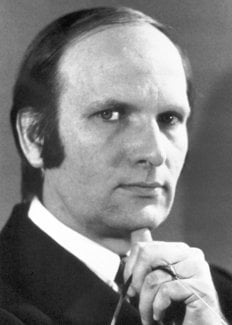Robert Schrieffer
Biographical

John Robert Schrieffer was born in Oak Park, Illinois on May 31, 1931, son of John H. Schrieffer and his wife Louis (née Anderson). In 1940, the family moved to Manhasset, New York and in 1947 to Eustis, Florida where they became active in the citrus industry.
Following his graduation from Eustis High School in 1949, Schrieffer was admitted to Massachusetts Institute of Technology, where for two years he majored in electrical engineering, then changed to physics in his junior year. He completed a bachelor’s thesis on the multiple structure in heavy atoms under the direction of Professor John C. Slater. Following up on an interest in solid state physics developed while at MIT, he began graduate studies at the University of Illinois, where he immediately began research with Professor John Bardeen. After working out a problem dealing with electrical conduction on semiconductor surfaces, Schrieffer spent a year in the laboratory, applying the theory to several surface problems. In the third year of graduate studies, he joined Bardeen and Cooper in developing the theory of superconductivity, which constituted his doctoral dissertation.
He spent the academic year 1957-58 as a National Science Foundation fellow at the University of Birmingham and the Niels Bohr Institute in Copenhagen, where he continued research in superconductivity. Following a year as assistant professor at the University of Chicago, he returned to the University of Illinois in 1959 as a faculty member. In 1960 he returned to the Bohr Institute for a summer visit, during which he became engaged to Anne Grete Thomsen whom he married at Christmas of that year.
In 1962 Schrieffer joined the faculty of the University of Pennsylvania in Philadelphia, where in 1964 he was appointed Mary Amanda Wood Professor in Physics. In 1980 he was appointed Professor at the University of California, Santa Barbara and to the position of Chancellor Professor in 1984. He served as Director of the Institute for Theoretical Physics in Santa Barbara from 1984-89. In 1992 he was appointed University Professor at Florida State University and Chief Scientist of the National High Magnetic Field Laboratory.
He holds honorary degrees from the Technische Hochschule, Munich and the Universities of Geneva, Pennsylvania, Illinois, Cincinnati, Tel-Aviv, Alabama. In 1969 he was appointed by Cornell to a six-year term as a Andrew D. White Professor-at-Large.
He is a member of the American Academy of Arts and Sciences, the National Academy of Sciences of which he is a member of their council, the American Philosophical Society, the Royal Danish Academy of Sciences and Letters and the Academy of Sciences of the USSR.
His awards include the Guggenheim Fellowship, Oliver E. Buckley Solid State Physics Prize, Comstock Prize, National Academy of Science, the Nobel Prize in Physics shared with John Bardeen and Leon N. Cooper in 1972, John Ericsson Medal, American Society of Swedish Engineers, University of Illinois Alumni Achievement Award, and in 1984 the National Medal of Science. The main thrust of his recent work has been in the area of high-temperature superconductivity, strongly correlated electrons, and the dynamics of electrons in strong magnetic fields.
The Schrieffers have three children, Bolette, Paul, and Regina.
This autobiography/biography was written at the time of the award and first published in the book series Les Prix Nobel. It was later edited and republished in Nobel Lectures. To cite this document, always state the source as shown above.
Robert Schrieffer died on 27 July 2019.
Nobel Prizes and laureates
Six prizes were awarded for achievements that have conferred the greatest benefit to humankind. The 12 laureates' work and discoveries range from proteins' structures and machine learning to fighting for a world free of nuclear weapons.
See them all presented here.
